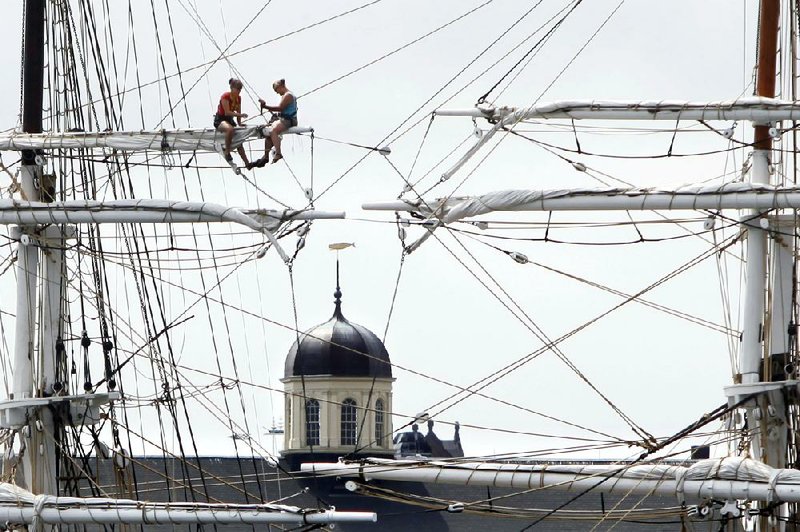CHARLESTON, S.C. -- As one of the year's busiest travel weekends approaches, so does Tropical Storm Arthur, expected to grow into a hurricane by the Fourth of July and hit North Carolina's Outer Banks, a popular getaway spot of barrier islands along the shore.
The first named storm of the Atlantic hurricane season prompted a hurricane warning for a wide area of the North Carolina coast and spurred authorities to order a mandatory evacuation for visitors to the Outer Banks' Hatteras Island as of 5 a.m. today.
The forecast did not call for a landfall in the U.S., but areas were warned of approaching rain, wind and potential riptides.
The Outer Banks will be especially vulnerable, forecasters said. The area's tourism agency expects about 250,000 people to travel there and stay in hotels and rental homes for the long holiday weekend.
"We want everybody to be safe and prepared, but we are not overly concerned at this point," said Lee Nettles, the executive director the Outer Banks Visitors Bureau. He noted that forecasters were predicting the storm would move fast and be less severe than others in recent memory.
But flooding concerns remained: Twice in recent years, storm-driven waves have sliced North Carolina Highway 12, the only road from the islands to the mainland, rendering it impassable. On Ocracoke Island, which is accessible only by ferry, a voluntary evacuation was announced.
Stores said North Carolina residents were buying generators, lanterns and flashlights, but even some workers weren't yet concerned.
"I've been through Irene. I went through Isabelle," said Bill Motley, who works at Ace Hardware in Nags Head and has lived on the Outer Banks for 13 years. "I'm not even worried about this one. I'm more worried about my tomato plants. With the wind coming, if we get a 50 mph gust, it will knock over my tomato plants."
At a news conference, Gov. Pat McCrory advised residents, "Don't put your stupid hat on." With concerns of riptides, he urged surfers and swimmers not to get in the water regardless of how good the waves might be.
"Our major goal is to ensure that no lives are lost," including those of emergency workers, McCrory said. He declared a state of emergency for 25 coastal and adjoining counties.
Late Wednesday, Arthur was about 160 miles southeast of Charleston, S.C., at latitude 30.6 north and longitude 79.1 west. It was moving north about 8 mph with maximum sustained winds of 70 mph.
The National Hurricane Center predicted it would grow to a Category 1 hurricane with sustained winds of at least 74 mph either later Wednesday night or sometime today.
The worst of the storm should occur at Cape Hatteras, N.C., about dawn Friday, with 3 to 5 inches of rain and sustained winds up to 85 mph, said Tony Saavedra, a meteorologist at the National Weather Service. Forecasters said that by later Friday, the effects of Arthur would be past the Outer Banks.
The Hurricane Center predicted the storm would be off the coast of New England later in the day and eventually make landfall in Canada's maritime provinces as a tropical storm.
In the Myrtle Beach area, the heart of South Carolina's $18 billion tourism industry, Arthur was expected to move past by tonight, spinning wind gusts from 40 to 50 mph toward the high-rise hotels and condominiums lining the oceanfront.
Farther south, in Hilton Head Island on the state's southern tip, most were confident the storm would pass well out at sea.
"It will be a sold-out weekend," said Charlie Clark, a spokesman for the local Chamber of Commerce. "We're not getting calls from visitors asking what's up with this storm."
Back on North Carolina's storm-tested Hatteras Island, one longtime resident said she had stocked up on supplies but was otherwise unfazed by Arthur's approach.
Even though Dawn Taylor had to put coolers on the top floor of her home in Avon to catch the rain after Hurricane Irene damaged the roof in 2011, she won't leave her home because of the hurricane. Even her 85-year-old father is staying put with her.
But she said she would advise less experienced tourists to think twice before riding things out on the island.
"It's not their environment. They're not used to it," she said. "It's a whole different world out here, a whole different lifestyle."
Information for this article was contributed by Emery P. Dalesio, Martha Waggoner, Matt Small and Tony Winton of The Associated Press.
A Section on 07/03/2014

